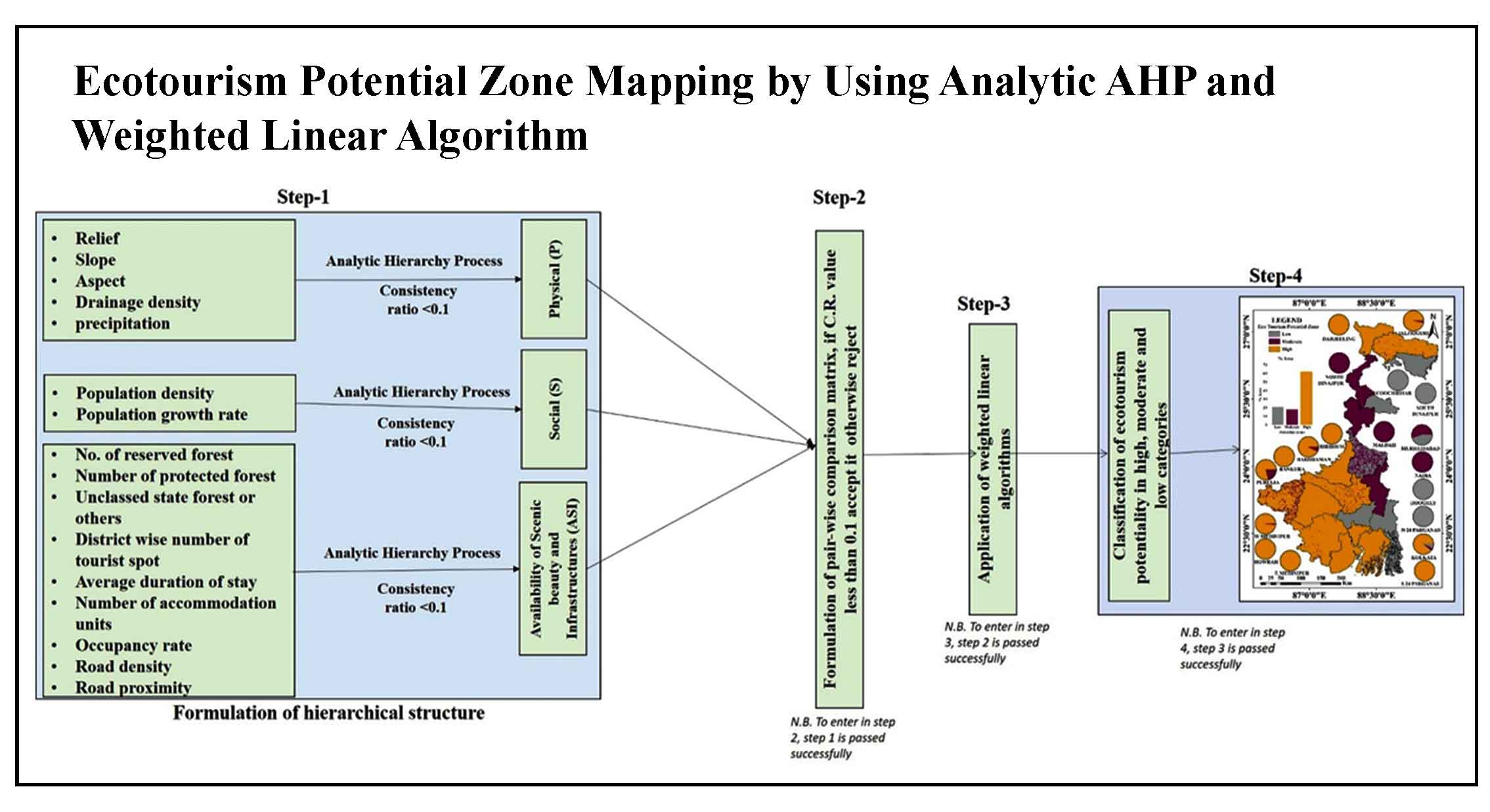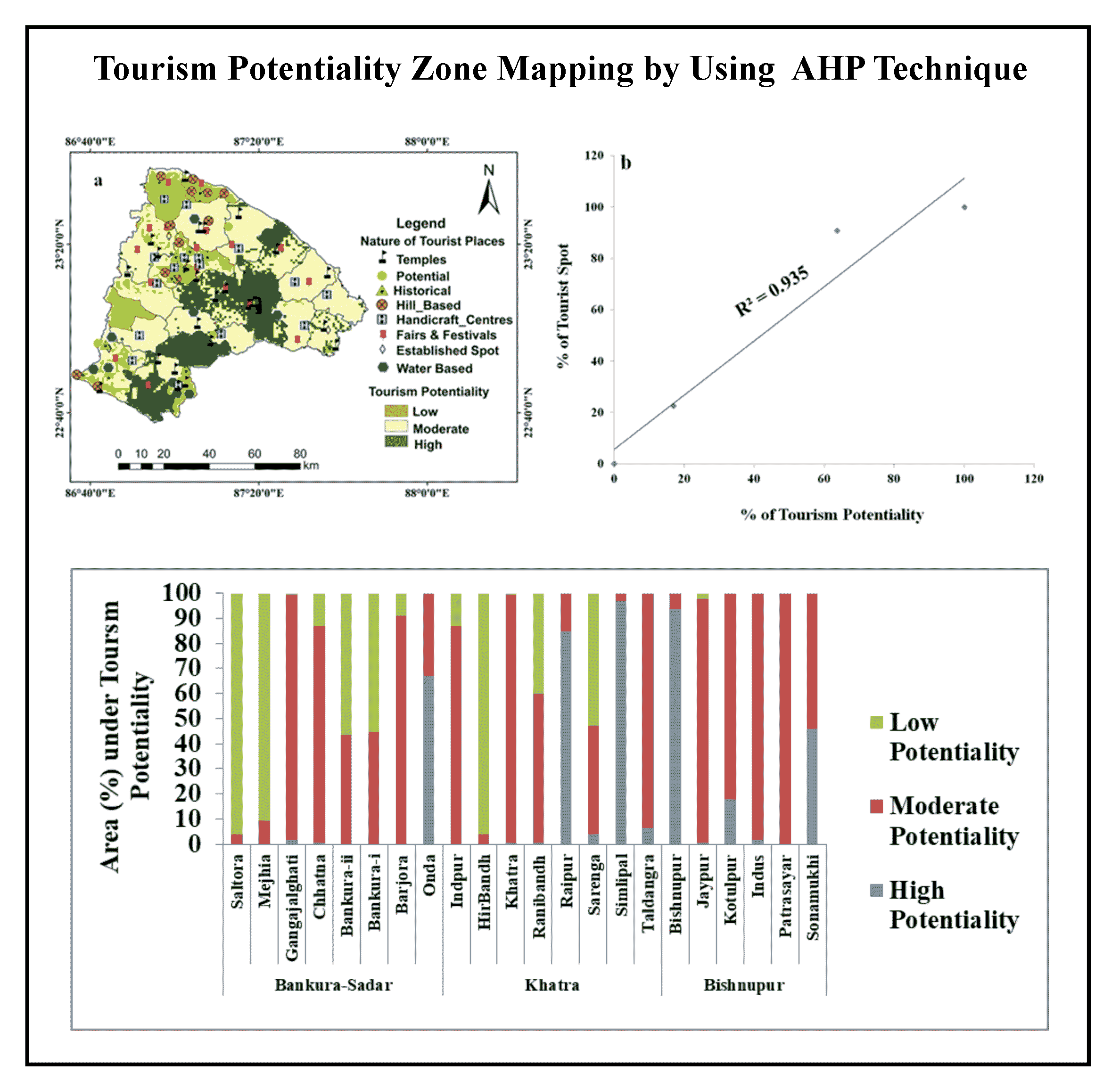Article Title :
Ecotourism Potential Zone Mapping by Using Analytic Hierarchy Process (AHP) and Weighted Linear Algorithm: A Study on West Bengal, India 
5 (2021)
44-64
Analytic Hierarchy Process , AHP , Dominant and Distinctive Function , Ecotourism Potential Zones , weighted linear algorithm


This study was designed to demarcate the Ecotourism Potential Zones (ETPZs) of West Bengal using the Analytic Hierarchy Process (AHP) and weighted linear algorithm by considering three sustainable tourism parameters and sixteen indicators. Those three parameters are 1) physical (P), 2) social (S), and 3) availability of scenic beauty and infrastructures (ASI). Overall, 5 parameters are merged under physical (P), 2 parameters are integrated under social (S), and 9 parameters are incorporated under availability of scenic beauty and infrastructures (ASI). A 4-step procedure has been adopted for this study: 1) a simple hierarchical structure has been outlined, 2) pair-wise comparison matrices are formed, 3) weighted linear algorithm technique is utilized to get the ecotourism potentiality zone, and 4) ecotourism potentiality map is classified into high, moderate and low categories based on the principle of Dominant and Distinctive Function (DDF). As a result, about 61.65% area is identified with high ecotourism potential zone, 17.86% area is observed under the moderate ecotourism potential zone, and 20.48% area is recognized as the low ecotourism potential zone. Thus, the study considers an exceptional methodological framework that is applicable in any region of the world.

Ecotourism potential zones are demarcated using three sustainable tourism parameters and sixteen indicators.
Five parameters are merged under physical (P), 2 parameters are integrated in social (S) and 9 parameters are incorporated under availability of scenic beauty and infrustructures (ASI).
Analytic Hierarchy Process (AHP) and Weighted Linear Algorithm techniques are used for the study.
About 61.65% area is identified with high ecotourism potential zone, 17.86% area is observed under the moderate ecotourism potential zone, and 20.48% area is recognized as the low ecotourism potential zone.
The study considers an exceptional methodological framework that is applicable in any region of the world.
Abraham, B. G., Rajasenan, D., 2015. Community Participation in Ecotourism: An Inclusive Development Option for Kerala (Doctoral dissertation, Cochin University of Science And Technology).
Agapiou, A., Lysandrou, V., Alexakis, D. D., Themistocleous, K., Cuca, B., Argyriou, A., Sarris, A, and Hadjimitsis, D. G., 2015. Cultural heritage management and monitoring using remote sensing data and GIS: The case study of Paphos area. Cyprus. Computers, Environment and Urban Systems, 54, 230-239.
Cetin, M. and Sevik, H., 2016. Assessing potential areas of ecotourism through a case study in Ilgaz Mountain National Park. Tourism-from Empirical Research towards Practical Application, 81-110.
Dasgupta, P., 2016. Understanding associations: health, socio-economic wellbeing and climate. In Climate Sensitive Adaptation in Health, 61-83. Springer, New Delhi.
Dutta D. and Gupta S., 2021. Rising trend of air pollution and its decadal consequences on meteorology and thermal comfort over Gangetic West Bengal, India. In: Shit P.K., Adhikary P.P., Sengupta D. (Eds) Spatial Modeling and Assessment of Environmental Contaminants. Environmental Challenges and Solutions. Springer, Cham.
Endalew, D., 2017. The Impact of Artisanal Gold Mining On Land Use–Land Cover Change of Kurmuk Woreda Benishangl-Gumuz Regional State, Western Ethiopia (Doctoral dissertation).
Fabac, R. and Zver, I., 2011. Applying the modified SWOT-AHP method to the tourism of Gornje Međimurje. Tourism and Hospitality Management, 17(2), 201-215.
Falabi, M.O. and Olatunji, A. G., 2014. Considering Entrepreneurship in Tourism for Sustainable Development in Nigeria. Journal of Business Education, Kwara State University. 2 (1), 176-194.
Ghamgosar, M., Haghyghy, M., Mehrdoust, F. and Arshad, N., 2011. Multicriteria decision making based on analytical hierarchy process (AHP) in GIS for tourism. Middle-East Journal of Scientific Research, 10(4), 501-507.
Ghosh, P., 2014. Subsistence and biodiversity conservation in the Sundarban Biosphere Reserve, West Bengal, India. Theses and Dissertations- Geography. 26.
Haque, M., Reza, M., Alam, M., Ahmed, Z. U. and Islam, M., 2016. Discovery of a potential site for community-based sustainable ecotourism in the Sundarbans Reserve forests, Bangladesh. Wasiul, Discovery of a Potential Site for Community-Based Sustainable Eco-tourism in the Sundarbans Reserve Forests, Bangladesh, 553-566.
Hasler, B., Smart, J. C. R., Fonnesbech-Wulff, A., Andersen, H. E., Thodsen, H., Mathiesen, G. B., Smedbergc, E., Göked, C., Czajkowskie, M., Wasf, A., Elofssong, K., Humborgc, C., Wolfsberga, A. and Wulff, F., 2014. Hydro-economic modelling of cost-effective transboundary water quality management in the Baltic Sea. Water Resources and Economics, 5, 1-23.
Karim, R. and Karmaker, C. L., 2016. Machine selection by AHP and TOPSIS methods. American Journal of Industrial Engineering, 4(1), 7-13.
Khalil, S., 2017. Potentiality assessment for ecotourism in rural communities: A case of Fayoum Governorate, Egypt. International Journal of Heritage, Tourism, and Hospitality, 10(2/2).
Krakauer, B. S., 2014. Negotiations of modernity, spirituality, and Bengali identity in contemporary Bāul-Fakir music (Doctoral dissertation).
Mohanty, P., 2008. Hotel Industry and Tourism in India. APH Publishing.
Narasimmaraj, R., 2014. Carrying Capacity and Community Participation for Sustainable Nature Based Tourism in Ooty an Evaluative Study (Doctoral dissertation).
Rahman, L. M., 2000. The Forest Act 1927.
ramos-quintana, f., tovar-sã¡nchez, e., saldarriaga-norena, h. and sotelo-nava, h., sanchez-hernandez, j. p.; castrejon-godinez, m.-l., 2019. a cbrâahp hybrid method to support the decision-making process in the selection of environmental management actions. Sustainability, 11(20), 1-30
Ryngnga, P. K., 2008. Ecotourism prioritization: A geographic information system approach. South Asian Journal of Tourism and Heritage, 1(1), 49-56.
Saaty, T. L., 1980. The analytic hierarchy process: Planning, priority setting, resource allocation. McGraw Hill, New York.
Shakeel, T., 2001. Amrita Shergil and her Contemporaries (Doctoral dissertation, Aligarh Muslim University).
Sharpley, R., 2014. Sustainability: A Barrier to Tourism Development?. In Tourism and Development (428-452). Channel View Publications.
Singh, T. V., 2017. Tourism and development: Not an easy alliance. In Tourism and Economic Development (30-41). Routledge.
Tomlinson, R. F., 2007. Thinking about GIS: geographic information system planning for managers. ESRI, Inc.
Torras, M., 2019. Welfare, Inequality and Resource Depletion: A Reassessment of Brazilian Economic Growth. Routledge.
Ullah, K. M. and Hafiz, R., 2014. Finding suitable locations for ecotourism development in Cox’s Bazar using geographical information system and analytical hierarchy process. Geocarto International, 29(3), 256-267.
Wanyonyi, J. W., Imwati, A. and Boitt, M., 2016. GIS in analysis of potential sites for ecotourism–a case study of Kwale County. IOSR Journal of Environmental Science, Toxicology and Food Technology, 10(10), 43-49.
West, O., 2014. Chapter two assessment of the ecological footprint of agricultural land use of West Bengal, India Biswajit Ghosh And Namita Chakma. Development, Environment and Sustainable Livelihood, 24.
Western, D., 1993. Defining ecotourism. K. Lindberg. D. Hawkins (Eds.), Ecotourism: A Guide for Planners and Managers. The Ecotourism Society, North Bennington







